Q&A – Ask Neil: August 3, 2023
(Please read these instructions carefully.)
Before you post your question, please look at recent issues to see if someone else has already asked it. You might find your answer there.
How to submit your question…
(Note: You may need to allow a pop-up window to come up in order to get the link for sending your photo(s). If you have already submitted your question and didn’t see the pop-up window, please click here.)
• Click the link provided below to post your question. After you submit your question, a new window will pop up giving you the address to which you can e-mail a SHARP, HIGH-RESOLUTION PHOTO to accompany your question. Please DO NOT SEND THUMBNAIL PHOTOS in case I need to zoom in to see things.
• Click here to post your question.
• Please ONLY POST YOUR QUESTION ONE TIME. We can only accept a set number of questions each week, and when we get duplicates it costs other people their chances.
• One question per reader, please.
• Please use this only for posting questions – not for standard emails.
• Watch for your answer in the following week’s e-gardens.
• I choose those of greatest general interest. For example, plant IDs seldom make the cut.
• I must have your first name or initials.
• I must have your city or county. (Texas is a very large state.)
QUESTION 1
WHY ARE MY RIVER BIRCH TREES LOSING YELLOWED LEAVES FASTER AND IN GREATER QUANTITIES THIS YEAR?
Question: My three river birch trees are losing their yellowed leaves in much greater quantities this year, beginning about the time our rains tapered off. They are about 10 years old. Why is this happening? Judith H., Tyler.
Answer: I think you answered your own question without realizing it. River birches love water (hence their name). The change from our spring rains to hot summer weather was really abrupt this year and many of our plants reacted accordingly. I’d also suggest you check the plants’ trunks for signs of borer holes or any other evidence of damage. Without a photo, those would be my beginning suggestions.
QUESTION 2
WHAT IS HAPPENING TO MY OAK TREE?
Question: What is happening to my oak tree? Was this caused by lightning, or something else? Earl H., Fort Worth.
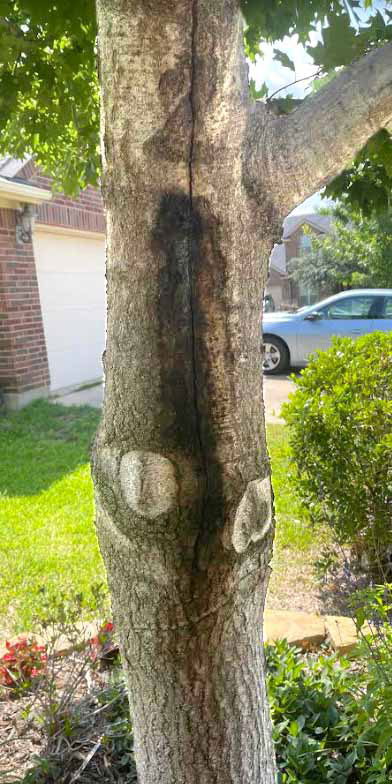
Answer: Without seeing any more of the tree, I’d doubt that this is lightning damage. That normally would have blasted the trunk open and knocked bark off the tree. This looks like more of the radial shake you’ve seen me describe for live oaks and red oaks here the past 12-18 months. It was caused by the extreme cold of late February 2021, and it caused many oaks and other species to lose large portions of their bark. I’d suggest leaving the tree alone to heal on its own. You could also hire a certified arborist to come on site and examine the tree more carefully. This is beyond the sun scald stage you may have seen me mention. This tree has a good leaf canopy to shade its trunk, so the sun should not have been a problem. Unless there are dead branches higher up that I’m not seeing in the photo, just sit tight and let it heal.
QUESTION 3
HOW OFTEN SHOULD I APPLY TIMED-RELEASE PLANT FOOD?
Question: I feed my potted plants and hanging baskets every time I water with a water-soluble fertilizer. How often can I supplement with the timed-release fertilizer? Melinda A., Frisco.
Answer: It will depend on the product you buy. Manufacturers use different coatings to get the timed-release feature. It takes weeks or months for the coating to dissolve and release the nutrients inside. One thing I have been told by several sources is that those coatings break down more rapidly in hot weather than they do in cooler conditions. Manufacturers generally suggest that you count on the timed-release aspect lasting about half as long as the container says here in Texas. That means if you have a 3-month product, you could think about another feeding in 6 or 8 weeks, not 3 months.
QUESTION 4
HOW DO I SELECT THE NEW TRUNK FOR MY TREE?
Question: As per your instructions earlier, I have cut, fertilized, watered and gotten “vigorous growth.” Your directions said to select and train the straightest, strongest single trunk that grows out from the trunk that remains. They grew from the side but up. Do I choose just one and cut the rest? Single stake? Pam B., Rockwall.
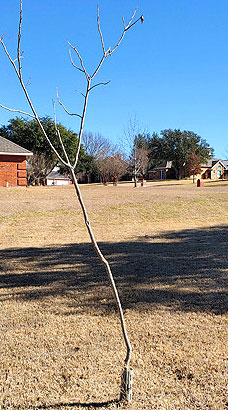
(I have included the photo from the original question back in March 2023.)
Answer: The trim has worked perfectly! And thanks for including the first photo for comparison.
The important thing to remember is that as the tree’s trunk grows larger over the years it’s going to absorb any crook caused by the trimming you did. All will be fine and unnoticeable within a few years.
That said, my choice would be the lower shoot of Photo 2 (the one going out the left side of the photo). I had already begun my reply saying just the opposite, but then I looked at the more distant photo and decided that the lower shoot is adequately straight and probably has a better connection to the original trunk. (That’s assuming that both of the current photos were taken from the same side of the tree.)
I would very carefully trim off the top shoot. It doesn’t appear that there is very much old trunk remaining between that point and the shoot you’re going to leave. You certainly don’t want to have a stub left in place, so if there is more than 1/2-inch of the old trunk, you may have to do a very patient and careful trim to remove the remnant. I can’t see it to advise you.
I would put one very strong post (probably a pressure-treated 2×2) alongside and behind the new shoot and use plastic plant tie to secure it to the post in several locations. Be sure it is vertical and that it stays vertical. Other than that, I think you’re on your way.
QUESTION 5
SHOULD I CONTINUE TREATING MY LAWN FOR PROBLEMS?
Question: This is my backyard. I have treated this area for chinch bugs, grub worms, and gray leaf spot, all according to manufacturers’ directions (and at the appropriate time of year). Should I continue on this path? Bruce G., San Antonio.
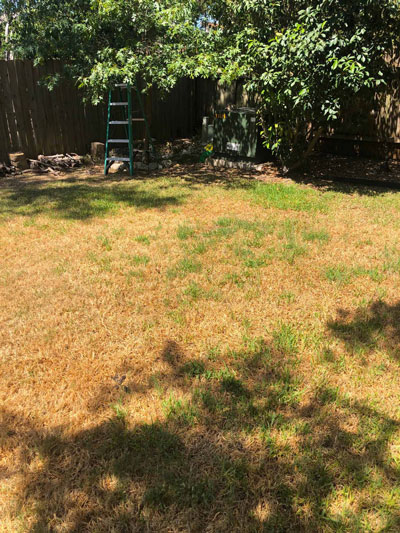
Answer: When I opened your photo, it screamed out “chinch bugs.” I would suspect that you may have used a product labeled to control them, and you may have applied it at the time of year that is recommended (hottest part of the summer), but I’ll bet they had already taken over and done massive damage. It can happen so quickly that big parts of lawns can be lost before any control measures are taken. I saw tons of this last summer during that dreadful heat wave and drought, and it’s coming back to the same hot, sunny parts of our yards.
Yes, if you want St. Augustine, you should stay the course. However, you’re probably going to have to replant some areas of your backyard, and you’ll certainly need to be on alert every summer for the telltale symptoms of grass that appears dry yet doesn’t respond to irrigation. Chinch bugs will come back to the very same spots. Your local independent retail garden center, hardware store or feed store can show you several options in labeled insecticides.
QUESTION 6
HOW CAN I CONTROL THESE WEEDS WITHOUT HARMING MY BERMUDA LAWN?
Question: What weeds do I have, and what can I use to eliminate them in my bermudagrass lawn that won’t hurt the turf? Chia Liao, Little Elm.
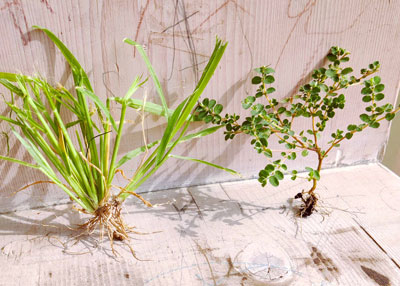
Answer: I’m not sure what grass you have, but it looks succulent enough that I’d guess it to be an annual species. If so, preemergent granules applied March 5-15 and repeated June 5-15 (90 days later) would prevent its germination. Options include Dimension, Balan and Halts. There is nothing you can use to get rid of existing grass plants. Herbicides don’t differentiate between “good grasses” and “bad grasses.”
As for the other weed, that’s spurge. It grows flat to the ground and produces a milky white sap that is quite sticky if you pull the plants out. You can control spurge with a broadleafed weedkiller spray, but you can also discourage it by taking the best possible care of the turf. Vigorous grass will usually crowd this weed out.
QUESTION 7
WHAT HAS CHEWED THE BARK ON OUR FRUITLESS MULBERRY?
Question: Something started chewing the bark on our fruitless mulberry a couple of months ago. This past week I noticed leaves on the grass beneath the affected branches. It was just leaves from those branches that turned brittle and fell. What caused this and what can we do? Kati H., Richardson.
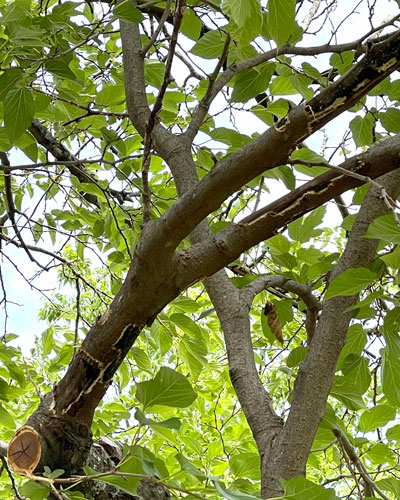
Answer: Squirrels do this to keep their teeth sharpened and ground down. Like our fingernails, without this kind of activity and lacking pecans, acorns, and other hard surfaces to crack, they have few other ways to keep their teeth from growing through their gums. When a branch loses its bark it stops free flow of water and nutrients. Subsequently that branch will often die. It happens frequently in the tops of pecans and live oaks.
Unfortunately, there isn’t much you can do to stop it. A product called Tree Tanglefoot would strongly discourage squirrels from climbing the trunk, but you would need to be sure they have no other access to the tree. You might also be able to capture them in a humane trap, but you’d have to transport them 10 or 15 miles to release them in a safe environment.
QUESTION 8
DO MY CONEFLOWERS HAVE A FUNGUS?
Question: Everything I’ve read about coneflowers says that they’re easy. However, I’m wondering if I might have some fungus in the soil. What is going wrong? Pamela B., Celina.
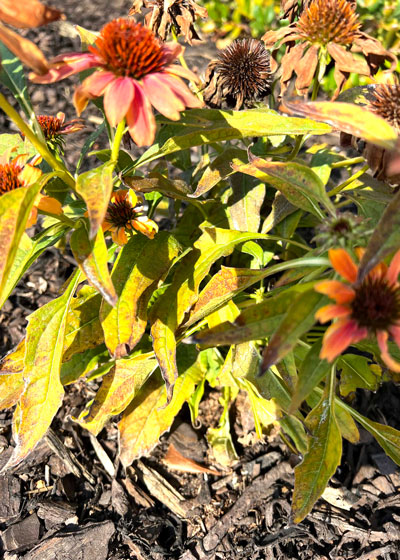
Answer: I’ve grown a lot of gloriosa daisies and coneflowers in my time, and my experience has always been that the large, exotic types like your gloriosa daisies are primarily lovely annuals that bloom for 4-6 weeks. I believe they’ve just run their course with the heat. I see no signs of a fungus. If you want a truly perennial display, opt instead for a variety like Goldsturm gloriosas. There is a large bed at our church that blooms every summer for 8 weeks from late May through most of July. It will come back the next spring stronger than ever. You will also usually find that purple coneflowers make nice perennials for several years. They do multiply within their beds so that you can keep them going as well.
QUESTION 9
WHAT IS HAPPENING TO MY LAWN?
Question: Thanks for taking my phone call on the air, and thanks for the chance to follow up with photos.
We have been in our house for 6 years. This is the first year with these issues.
• The grass grows back in streaks after it is mowed. All-green streaks and all-brown streaks.
• There are very concentrated browned areas. I have adjusted the sprinkler system and I move the trampoline before and after irrigation.
• I use a lawn care company. The yard has had all the recommended treatments (pre-emergents, early season fertilizers, etc.). They missed a recent application of fertilizer, so I made it myself on the last two occasions. I was careful to use the right settings for the 16-4-8 product.
What might be happening? John B., Roanoke.
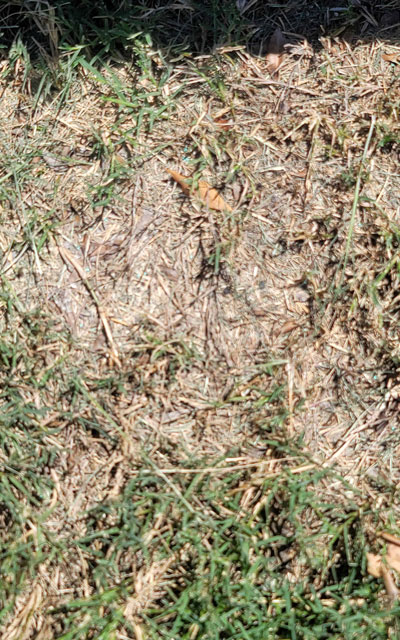
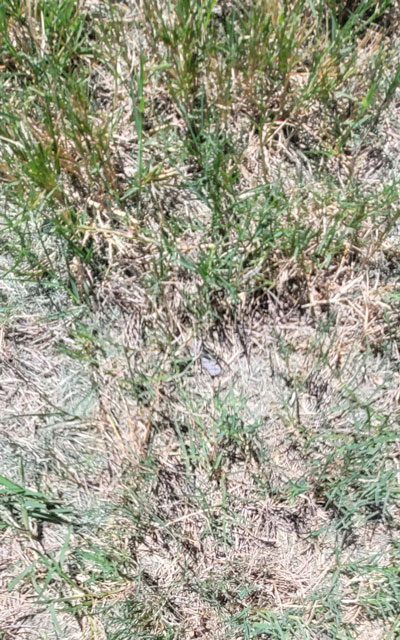
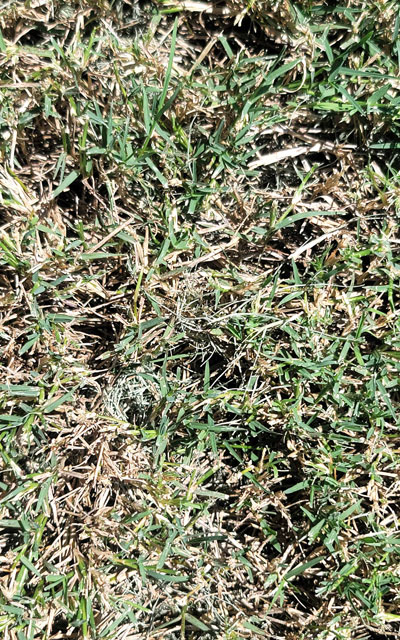


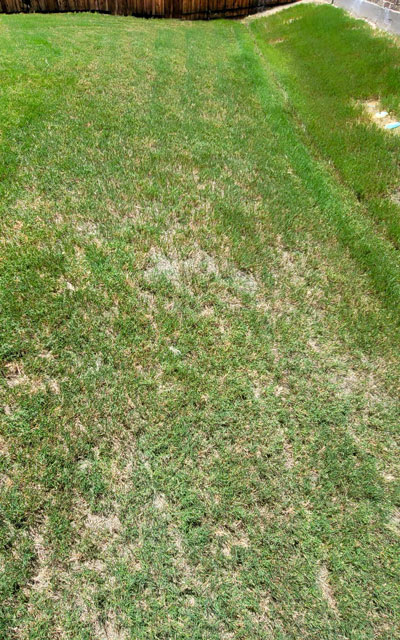
Answer: Let me give this my best shot. And thanks for the several photos and thorough explanation.
Odd as it seems, I can’t tell what type of lawngrass you have. One closeup looks like St. Augustine, in which case the big brown patch would probably be due to chinch bugs. In another photo it looks more like bermuda, and a couple of the photos look like there could be an accumulation of thatch on top of the bare soil. That could be sufficient to take the lawn downhill with it.
The one thing that does show up in several of your photos is that the mower is cutting unevenly. Either the wheels on one side are set one notch lower than the other side, or (more likely), if you are bagging the clippings, the weight of the bag is pulling the mower down on the bagging side. You need to empty the bag much more often. Notice that you don’t see the uneven cut in the areas where the grass is brown. That leads me to believe it’s the bagging and not the wheel settings.
Read up on thatch. The short-form answer is that it’s the accumulation of clippings that pack together before they can decay. They mat down on top of the soil preventing air, water, and nutrients from getting into the soil and excess water from getting out. You can pick thatch up like fiberboard.
If you find such a layer, be sure you are applying only a high-quality fertilizer with 30 to 40 percent slow-release nitrogen. For the record, phosphorus (second number of the three-number analysis) is not needed in most Texas soils. Catch the clippings or mow every 4 or 5 days so the clippings will be short, and use a mulching mower to chop them up really fine. You might even consider renting a core aerator to create holes through the thatch layer. But do all of this only if you find sound evidence of thatch.
Somewhere in there I believe I have your answer. I wish the close-up photos had been a bit more sharp, but hopefully this will be of help.

